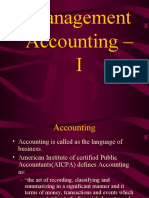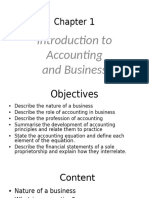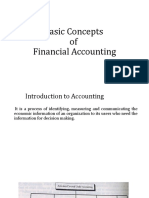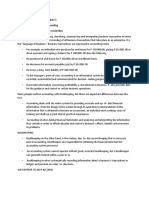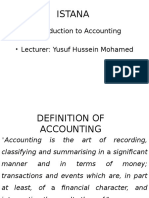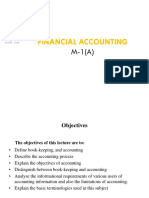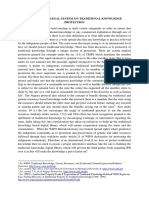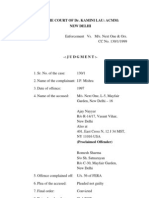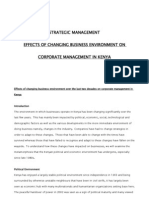Introduction To Accounting: Accounting The Language of Business
Uploaded by
Gopal KrishnanIntroduction To Accounting: Accounting The Language of Business
Uploaded by
Gopal KrishnanUNIT I
INTRODUCTION TO
ACCOUNTING
Accounting
The Language of Business
2
The Value of Accounting
Why does accounting exist in every
organization?
I explain this question in another way:
what kind of unique value does
accounting possess?
The value must be fundamental and the
society could not go without;
Without trust, we could not have even a
family, let alone a firm
3
The Value of Accounting
Accounting is proven to be cost-effective;
It is suitable to all kinds of firms,
No matter of their size,
No matter of the geographic locations;
No matter of ownership;
Now that accounting is connected with human
nature and trusting issue, we may trace the history
of accounting to the early days of human beings,
or ancient Society;
4
The Evolution of Accounting
Why do our ancestors invent Alphabet?
To build trusting via enhanced memory;
This is the right value of Accounting.
Chronology of spelling by Steve Bett (Ancient Egyptian and
the dawn of writing);
Writing developed as an extension of the accounting
system in Babylon;
A British accounting scholar claimed:
Phoenician invented ALPHABET
for the sake of accounting.
5
The Evolution of Accounting
The primitive stage of accounting;
A tool to help to maintain the trusts;
Alphabet, numeric and organizational
control;
The birth of double-entry bookkeeping
BOOK-KEEPING
Is the science and art of correctly recording in the
books of account all those business transactions that
result in the transfer of money or moneys worth.
The branch of knowledge which tells us how to keep a record
of business transactions.
Advantages:
Permanent, Reliable & Arithmetical accuracy
Net Results & Ascertainment of Financial Position & Progress
Calculation of Dues, Taxation and Mgt. Decision making
Control over Assets and borrowings
Fixing the selling price & Legality issues
Identifying Dos and Donts
Need and Importance
What has happened to the investment?
What is the result of the business transactions?
What are the earnings and expenses?
How much amount is receivable /Payable from/
to customers
From/To whom goods have been Purchased/ sold on
credit?
What are the nature and value of assets & Liabilities
possessed by the business concern?
What are the purpose of Accounting
Purpose of Accounting
i. Planning how you are going to use your money
ii. Recording accounting data.
iii. Keeping specific records of information in specific
manual.
iv. Enabling circulating information.
v. Use accounting data to make decision.
Identifies
Records
Communicates Relevant
Reliable
Comparable
Importance of Accounting
Accounting
is a
system that
information
that is
about an organizations
business activities.
1-9
Identifying
Business
Activities
Recording
Business
Activities
Communicating
Business Activities
Accounting Activities
1-10
ACCOUNTING
American Accounting Association defines
accounting as the process of identifying,
measuring and communicating economic
information to permit informed judgements and
decision by users of the information
The systematic and comprehensive recording of
financial transactions pertaining to a business.
The process of summarizing, analyzing and
reporting these transactions.
11
Objectives
The main objectives of accounting are:
1. To maintain accounting records
2. To calculate the result of operations
3. To ascertain the financial position
4. To communicate the information to users
Business
transactions
(monetary
value)
Identifying
Recording
Classifying
Summarizing
Analyzing
Interpreting
Communicating
Process
Information to
Users
Output Input
PROCESS OF ACCOUNTING
USERS OF ACCOUNTING INFORMATION
Owners & Management
Employees & Trade Unions
Creditors, Banks & Lending Institutions
Potential Investors & Present Investors
Government & Tax Authorities
Regulatory Agencies &
Researchers
15
Users of Accounting Information
External Users
Lenders
Shareholders
Governments
Consumer Groups
External Auditors
Customers
Internal Users
Managers
Officers
Internal Auditors
Sales Staff
Budget Officers
Controllers
1-16
BRANCHES OF ACCOUNTING
Financial accounting
Recording business transactions in the books of
accounts to found the operating result(FP) for a
particular period
Cost accounting
Collection, classification and ascertainment of the cost
of production or job undertaken by the firm
Management accounting
For the purpose of policy formulation, planning,
control and decision making by the management
17
Users of Accounting Information
External Users
Financial accounting provides
external users with financial
statements (shareholders, lenders,
etc.).
Internal Users
Managerial accounting provides
information needs for internal
decision makers (officers, managers,
etc.).
1-18
Basic accounting terms
1. Cash transaction
Cash receipt or payment
2. Credit transaction
Where cash is not involved immediately but will be paid
or received later
3. Proprietor
A person who owns a business
4. Capital
Amount invested by the proprietor in the business
5. Assets
Properties belongings to the business
Cont
6. Liabilities
Financial obligations of a business.
The amounts which a business owes to others.
7. Drawings
The amount of cash or value of goods
withdrawn from the business by the
proprietor for his personal use
Cont
8. Debtors
A person who receives a benefit without giving
money , but liable to pay in future or in due
course of time is debtor
9. creditors
A person who gives a benefit without receiving
money , but to claim in future is a creditor
Cont
10. Purchases
The amount of goods bought by a business for
resale or for use in the production.
11. Purchases return or returns outward
When goods are returned to the suppliers due
to defective quality or not as per the terms of
purchase
12.Sales
The amount of goods sold that are already
bought or manufactured by the company.
CASH SALES
Sold for Cash
CREDIT SALE
Sold but payment are not received at that time
TOTAL SALES
= Cash Sales + Credit Sales
13.Sales Return
14. Stock
15. REVENUE
Amount receivables or realized from sale of goods
Earnings from Interest, Commission, Dividend etc.
16.EXPENSES
Amount spent in order to produce and sell the goods
and services
17. INCOME
Difference between Revenue and Expenses
= Revenue Expenses.
18. Voucher
19. Invoice
20. Receipt
Assets
Liabilities +
Equity
Accounting Equation
Liabilities Equity Assets
= +
1-30
Accounting Equation
Fundamental Accounting Equation:
Assets = Liabilities + Owners Equity
This equation is always in balance
In order for this equation to remain in balance,
double-entry bookkeeping is employed.
That is, the recording of every transaction or event must
have at least two parts
Either an equal impact (increase or decrease) to both sides of the
equation or equal and opposite impact to one side.
The recording of every transaction must keep this equation
in balance
31
Land
Equipment
Buildings
Cash
Vehicles
Furnitures
Notes
Receivable
Accounts
Receivable
Resources
owned or
controlled by a
company
Assets
1-32
Taxes
Payable
Wages
Payable
Notes
Payable
Accounts
Payable
Creditors
claims on
assets
Liabilities
1-33
Owners
claim on
assets
Dividends
Contributed
Capital
Retained
Earnings
Equity
1-34
You might also like
- Year 9 Business Studies Term 3 Chapter 1 Bookkeeping and AccountingNo ratings yetYear 9 Business Studies Term 3 Chapter 1 Bookkeeping and Accounting4 pages
- Accounting: - American Institute of Certified Public AccountantsNo ratings yetAccounting: - American Institute of Certified Public Accountants11 pages
- Chapter 1 (Accounting Principle) - Đã G PNo ratings yetChapter 1 (Accounting Principle) - Đã G P251 pages
- Accounting - Definition: American Institute of Certified Public AccountantsNo ratings yetAccounting - Definition: American Institute of Certified Public Accountants37 pages
- Istana: - Introduction To Accounting - Lecturer: Yusuf Hussein MohamedNo ratings yetIstana: - Introduction To Accounting - Lecturer: Yusuf Hussein Mohamed53 pages
- Uses of Accounting Information and The Financial StatementsNo ratings yetUses of Accounting Information and The Financial Statements65 pages
- Need For Accounting Need For AccountingNo ratings yetNeed For Accounting Need For Accounting24 pages
- ACCY901 Accounting Foundations For Professionals: Topic 1100% (1)ACCY901 Accounting Foundations For Professionals: Topic 126 pages
- Chapter 2 - Accounting As The Language of Business100% (1)Chapter 2 - Accounting As The Language of Business41 pages
- EDITED The Definition, Nature and History of AccountingNo ratings yetEDITED The Definition, Nature and History of Accounting23 pages
- Yummy Ice-Cream!!!!: Offer!!!OFFER!!! FROM 21/12/2017 TILL 27/12/2017No ratings yetYummy Ice-Cream!!!!: Offer!!!OFFER!!! FROM 21/12/2017 TILL 27/12/20173 pages
- Week 1 Theories Concepts of EntrepreneurshipNo ratings yetWeek 1 Theories Concepts of Entrepreneurship21 pages
- Chapter Eight: South African Policy Framework For Start-UpsNo ratings yetChapter Eight: South African Policy Framework For Start-Ups19 pages
- Accounting Concepts and Conventions: Unit - INo ratings yetAccounting Concepts and Conventions: Unit - I30 pages
- Sakthi Institute of Information and Management Studies: (Feb 2011-AUQP)No ratings yetSakthi Institute of Information and Management Studies: (Feb 2011-AUQP)1 page
- Unit I: Accounting For Changes Prices (Inflation Accounting)No ratings yetUnit I: Accounting For Changes Prices (Inflation Accounting)18 pages
- Mergers & Acquisitions: How To Expand Your Business in Today's EnvironmentNo ratings yetMergers & Acquisitions: How To Expand Your Business in Today's Environment15 pages
- Positioning Products and Services in The Market: Unit IvNo ratings yetPositioning Products and Services in The Market: Unit Iv16 pages
- EFF Memorandum To Johannesburg Stock Exchange 27 October 2015No ratings yetEFF Memorandum To Johannesburg Stock Exchange 27 October 20153 pages
- Automotive Servicing Grade 7-8 PECS - Align One's PECS With That of A PractitionerentrepreneurNo ratings yetAutomotive Servicing Grade 7-8 PECS - Align One's PECS With That of A Practitionerentrepreneur3 pages
- Affidavit Undertaking For Name CorrectionNo ratings yetAffidavit Undertaking For Name Correction1 page
- The Current Legal System On Traditional Knowledge ProtectionNo ratings yetThe Current Legal System On Traditional Knowledge Protection2 pages
- Production Theory: Managerial EconomicsNo ratings yetProduction Theory: Managerial Economics44 pages
- Specifications - Mobilization / Demobilization: Wefvrwefewsdwdqehsdcqjsfhiuhfiekfnheqfq, Jeksfdscope of WorkNo ratings yetSpecifications - Mobilization / Demobilization: Wefvrwefewsdwdqehsdcqjsfhiuhfiekfnheqfq, Jeksfdscope of Work2 pages
- 7.1: Understanding The Organisation: Chapter 7: Organisation-Specific Study IiiNo ratings yet7.1: Understanding The Organisation: Chapter 7: Organisation-Specific Study Iii47 pages
- Changes in Kenyan Business Environment in The Last 2 Decades100% (5)Changes in Kenyan Business Environment in The Last 2 Decades5 pages
- Nepal Stock Exchange Limited: Singhadurbar Plaza, Kathmandu, Nepal. Phone: 977-1-4250758,4250735, Fax: 977-1-4262538No ratings yetNepal Stock Exchange Limited: Singhadurbar Plaza, Kathmandu, Nepal. Phone: 977-1-4250758,4250735, Fax: 977-1-426253815 pages
- Estimated Vs Actual Cost - Kitchen CabinetNo ratings yetEstimated Vs Actual Cost - Kitchen Cabinet12 pages
- Understanding Social Entrepreneurship - Inquirer OpinionNo ratings yetUnderstanding Social Entrepreneurship - Inquirer Opinion7 pages
- Year 9 Business Studies Term 3 Chapter 1 Bookkeeping and AccountingYear 9 Business Studies Term 3 Chapter 1 Bookkeeping and Accounting
- Accounting: - American Institute of Certified Public AccountantsAccounting: - American Institute of Certified Public Accountants
- Accounting - Definition: American Institute of Certified Public AccountantsAccounting - Definition: American Institute of Certified Public Accountants
- Istana: - Introduction To Accounting - Lecturer: Yusuf Hussein MohamedIstana: - Introduction To Accounting - Lecturer: Yusuf Hussein Mohamed
- Uses of Accounting Information and The Financial StatementsUses of Accounting Information and The Financial Statements
- ACCY901 Accounting Foundations For Professionals: Topic 1ACCY901 Accounting Foundations For Professionals: Topic 1
- Chapter 2 - Accounting As The Language of BusinessChapter 2 - Accounting As The Language of Business
- EDITED The Definition, Nature and History of AccountingEDITED The Definition, Nature and History of Accounting
- DK Essential Managers: Understanding AccountsFrom EverandDK Essential Managers: Understanding Accounts
- Yummy Ice-Cream!!!!: Offer!!!OFFER!!! FROM 21/12/2017 TILL 27/12/2017Yummy Ice-Cream!!!!: Offer!!!OFFER!!! FROM 21/12/2017 TILL 27/12/2017
- Chapter Eight: South African Policy Framework For Start-UpsChapter Eight: South African Policy Framework For Start-Ups
- Sakthi Institute of Information and Management Studies: (Feb 2011-AUQP)Sakthi Institute of Information and Management Studies: (Feb 2011-AUQP)
- Unit I: Accounting For Changes Prices (Inflation Accounting)Unit I: Accounting For Changes Prices (Inflation Accounting)
- Mergers & Acquisitions: How To Expand Your Business in Today's EnvironmentMergers & Acquisitions: How To Expand Your Business in Today's Environment
- Positioning Products and Services in The Market: Unit IvPositioning Products and Services in The Market: Unit Iv
- EFF Memorandum To Johannesburg Stock Exchange 27 October 2015EFF Memorandum To Johannesburg Stock Exchange 27 October 2015
- Automotive Servicing Grade 7-8 PECS - Align One's PECS With That of A PractitionerentrepreneurAutomotive Servicing Grade 7-8 PECS - Align One's PECS With That of A Practitionerentrepreneur
- The Current Legal System On Traditional Knowledge ProtectionThe Current Legal System On Traditional Knowledge Protection
- Specifications - Mobilization / Demobilization: Wefvrwefewsdwdqehsdcqjsfhiuhfiekfnheqfq, Jeksfdscope of WorkSpecifications - Mobilization / Demobilization: Wefvrwefewsdwdqehsdcqjsfhiuhfiekfnheqfq, Jeksfdscope of Work
- 7.1: Understanding The Organisation: Chapter 7: Organisation-Specific Study Iii7.1: Understanding The Organisation: Chapter 7: Organisation-Specific Study Iii
- Changes in Kenyan Business Environment in The Last 2 DecadesChanges in Kenyan Business Environment in The Last 2 Decades
- Nepal Stock Exchange Limited: Singhadurbar Plaza, Kathmandu, Nepal. Phone: 977-1-4250758,4250735, Fax: 977-1-4262538Nepal Stock Exchange Limited: Singhadurbar Plaza, Kathmandu, Nepal. Phone: 977-1-4250758,4250735, Fax: 977-1-4262538
- Understanding Social Entrepreneurship - Inquirer OpinionUnderstanding Social Entrepreneurship - Inquirer Opinion









